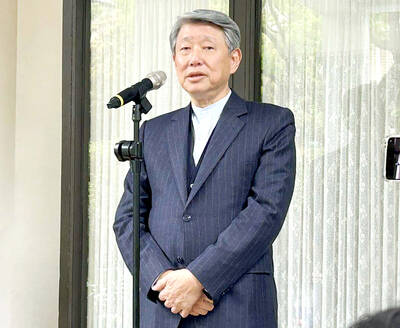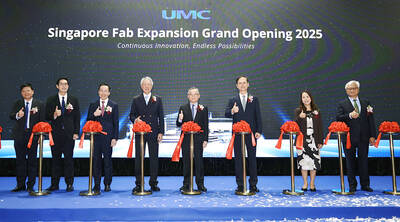Some smaller Chinese lenders cut interest rates for time deposits over the weekend, following a similar move by their larger rivals last year, after several lending rate reductions by policymakers started to squeeze their margins.
Rural lenders in provinces including Henan and Hubei lowered deposit rates by as much as 45 basis points on some tenors, according to their announcements.
After the adjustment, these lenders would pay an annual 1.9 percent for one-year deposits, down from the previous 2.25 percent.

Photo: Reuters
Chinese banks are facing mounting pressure to maintain profitability at a time when the authorities are ramping up efforts to boost the world’s second-largest economy.
The People’s Bank of China (PBOC) unexpectedly lowered the reserve requirement ratio late last month in a move that would give lenders more cash to disburse loans and drive down their funding costs.
While China’s economic activity is rebounding this year after lifting COVID-19 restrictions — with banks extending a record amount of new loans in January — analysts are cautious about the outlook for the sector.
State-owned banks posted a 13 percent decline in pre-provision operating profit, which is income before accounting for funds set aside for bad debts, in the final three months of last year — the worst quarter since 2010, Jefferies Financial Group Inc said.
Most of the banks also reported deteriorating net interest margins, a measure of profitability that would likely fall further this year.
China’s commercial banks have had some leeway in setting their own rates since the central bank scrapped direct control in 2005.
However, the PBOC maintains substantial sway by setting a ceiling and floor for rates through the interest rate self-disciplinary body.
The country’s benchmark one-year deposit rate for household savings is 1.5 percent. Smaller banks still pay well above their larger rivals and the benchmark after the latest adjustment.
More coordinated efforts are needed to curb disorderly competition for deposits and strengthen the industry’s risk management, as margin pressure is “tremendous,” Everbright Securities Co (光大證券) analyst Wang Yifeng (王一峰) said in a note to clients on Sunday.
China’s biggest banks in September last year lowered their benchmark deposit rates across the board for the first time since 2015, a move designed to help them boost lending to shore up the economy battered by COVID-19 restrictions and a deepening property crisis.

MULTIFACETED: A task force has analyzed possible scenarios and created responses to assist domestic industries in dealing with US tariffs, the economics minister said The Executive Yuan is tomorrow to announce countermeasures to US President Donald Trump’s planned reciprocal tariffs, although the details of the plan would not be made public until Monday next week, Minister of Economic Affairs J.W. Kuo (郭智輝) said yesterday. The Cabinet established an economic and trade task force in November last year to deal with US trade and tariff related issues, Kuo told reporters outside the legislature in Taipei. The task force has been analyzing and evaluating all kinds of scenarios to identify suitable responses and determine how best to assist domestic industries in managing the effects of Trump’s tariffs, he

TIGHT-LIPPED: UMC said it had no merger plans at the moment, after Nikkei Asia reported that the firm and GlobalFoundries were considering restarting merger talks United Microelectronics Corp (UMC, 聯電), the world’s No. 4 contract chipmaker, yesterday launched a new US$5 billion 12-inch chip factory in Singapore as part of its latest effort to diversify its manufacturing footprint amid growing geopolitical risks. The new factory, adjacent to UMC’s existing Singapore fab in the Pasir Res Wafer Fab Park, is scheduled to enter volume production next year, utilizing mature 22-nanometer and 28-nanometer process technologies, UMC said in a statement. The company plans to invest US$5 billion during the first phase of the new fab, which would have an installed capacity of 30,000 12-inch wafers per month, it said. The

Taiwan’s official purchasing managers’ index (PMI) last month rose 0.2 percentage points to 54.2, in a second consecutive month of expansion, thanks to front-loading demand intended to avoid potential US tariff hikes, the Chung-Hua Institution for Economic Research (CIER, 中華經濟研究院) said yesterday. While short-term demand appeared robust, uncertainties rose due to US President Donald Trump’s unpredictable trade policy, CIER president Lien Hsien-ming (連賢明) told a news conference in Taipei. Taiwan’s economy this year would be characterized by high-level fluctuations and the volatility would be wilder than most expect, Lien said Demand for electronics, particularly semiconductors, continues to benefit from US technology giants’ effort

‘SWASTICAR’: Tesla CEO Elon Musk’s close association with Donald Trump has prompted opponents to brand him a ‘Nazi’ and resulted in a dramatic drop in sales Demonstrators descended on Tesla Inc dealerships across the US, and in Europe and Canada on Saturday to protest company chief Elon Musk, who has amassed extraordinary power as a top adviser to US President Donald Trump. Waving signs with messages such as “Musk is stealing our money” and “Reclaim our country,” the protests largely took place peacefully following fiery episodes of vandalism on Tesla vehicles, dealerships and other facilities in recent weeks that US officials have denounced as terrorism. Hundreds rallied on Saturday outside the Tesla dealership in Manhattan. Some blasted Musk, the world’s richest man, while others demanded the shuttering of his